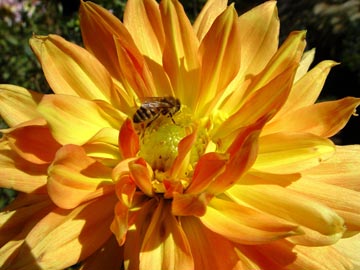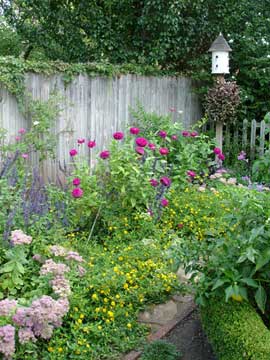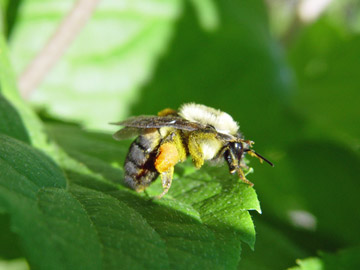 A bee collects pollen from this blooming dahlia.
A bee collects pollen from this blooming dahlia.
© George Weigel
The oft-feared bee is taking on a new and even appealing persona in the yard lately. Gardeners are getting the message that bees and their pollinating colleagues are essential to plant life as well as our own food supply. Like them or not, bees and bugs are responsible for pollinating three-quarters of the world’s plants. They’re also behind about one-third of every bite of food we take, according to the U.S. Department of Agriculture. Instead of the conventional objective of spraying away anything that flies, the latest trend is welcoming pollinating insects. Gardeners not only are sparing these bugs, but they’re actively trying to put more buzz in their landscapes by planting pollinator gardens.
 A growing trend in gardening lately is the “pollinator garden,” which is planned to attract to bees, butterflies and other pollinating insects.
A growing trend in gardening lately is the “pollinator garden,” which is planned to attract to bees, butterflies and other pollinating insects.
© George Weigel
Pollinator gardens are plantings designed to attract pollinating insects and help them flourish once they’re there. Besides bees, the pollinating cast includes butterflies, moths, flies, assorted non-stinging wasps and hummingbirds. Researchers say that habitat loss and rampant spraying have been reducing pollinator populations to problem levels. A watershed event occurred in 2006 when a new “colony collapse disorder” began killing masses of honeybees, enough to affect the nation’s fruit and nut crops.
Even in home gardens, gardeners have been noticing fewer berries on their ornamental plants and slimmer yields of tomatoes, cucumbers, blueberries and squash – all crops largely pollinated by insects. The bee decline in particular has been alarming enough that the U.S. government appointed a task force in 2015 to come up with solutions. Among its recommendations: stem the loss of pollinator habitats, take a new look at pesticides (especially bee-toxic ones), rethink our weed-management strategies on public land, and encourage more pollinator-friendly plantings. That last one is where home gardeners come into play. Researchers say that our urban and suburban landscapes are increasingly becoming the new refuge for pollinators. A garden here and a garden there won’t make a big difference by itself, but clusters of them can take on the role of the meadows and woodlands that construction displaced.
 Bees are nature’s hardest-working pollinators, as this pollen-laden bee shows.
Bees are nature’s hardest-working pollinators, as this pollen-laden bee shows.
© Susan Weigel
Planting more native plants is the leading advice given, under the premise that native pollinators and native plants evolved together and are of most value to one another. One pollinator-attracting change is to learn what plants are native to your region and add more of them to the landscape. Growers, garden centers and catalogs have made that easier in recent years by labeling plants native to the United States. Some have even narrowed it down to lists of plants that are native regionally. Though native plants are generally most useful, many non-native plants also attract and feed pollinators – especially the “generalists” that aren’t as picky as, say, the monarch butterfly, which lays eggs only on milkweed-family plants. Catmint, lavender, sedum, salvia, Russian sage, mints, lantana, daisies, alyssum and zinnias are among non-native species that often attract bees and other pollinators. A caveat with non-natives is that some of them have become invasive, such as Japanese barberries, Oriental bittersweet, purple loosestrife and many types of butterfly bush.
Since different pollinators prefer different plants for hosting their larvae, for food, and even at different life stages, coming up with a single plant list for all pollinator gardens is difficult, if not impossible. However, these principles usually get the job done:
- Knock off spraying. If you must use an insecticide, go with the most targeted and least toxic approach to control the pest, such as oils and soaps. Spray in the evening when most pollinators are least active.
- Plant more variety. Diversity alone gives pollinators a better chance of finding plants of value… certainly more than in a typical yard that’s primarily lawn and a handful of foundation evergreens. The Xerxes Society, a butterfly conservation group, recommends at least 15 to 25 different species per yard.
- Plant for continuous bloom. Pollinators can’t take a few weeks off from feeding in the summer. Different pollinators need a continuous supply of plants the whole way from beginning to end of the growing season. If you notice gaps in bloom during the season, add plants that flower in those down times.
- Plant in “floral clumps.” Rather than plant just one of a lot of different plants, plant five or more of the most attractive plants that bloom over a wide period of time. Pollinators will find them more readily and have more to lay eggs on and eat when they do.
- Give pollinators a water source. Birdbaths and water features are two good ways. Shallow puddles are also excellent if you refresh the water every few days to avoid mosquitoes.
Some of the best native plants for attracting pollinators:
Trees and shrubs: oak, black cherry, willow, birch, crabapple, blueberry, red maple, pine, hickory, hawthorn, spruce, linden, rose, beech, redbud, arrowwood viburnum, chokecherry, spicebush, silky or gray dogwood, serviceberry, New Jersey tea, buttonbush, summersweet, Virginia sweetspire.
Perennials for sun: aster, goldenrod, sunflower, Joe Pye weed, violet, hardy geranium, black-eyed susan, iris, milkweed, penstemon, phlox, threadleaf coreopsis, bee balm, cardinal flower, mountain mint, purple coneflower, columbine, liatris, anise hyssop, sundrops, sneezeweed, Culver’s root, heart-leaved alexander, nodding onion.
Perennials for shade: sedge, woodland phlox, blue lobelia, jack-in-the-pulpit, indian pink, wood aster, Dutchman’s breeches.